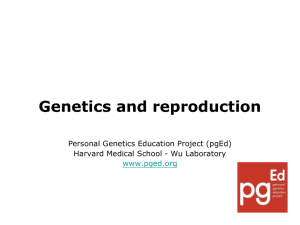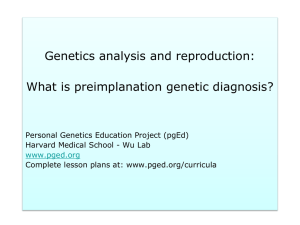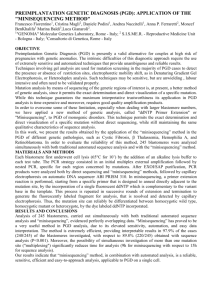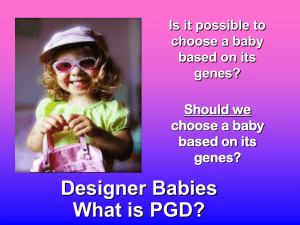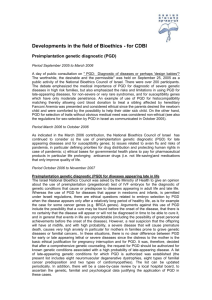Designer Babies: Creating Perfection or Breeding Trouble
advertisement
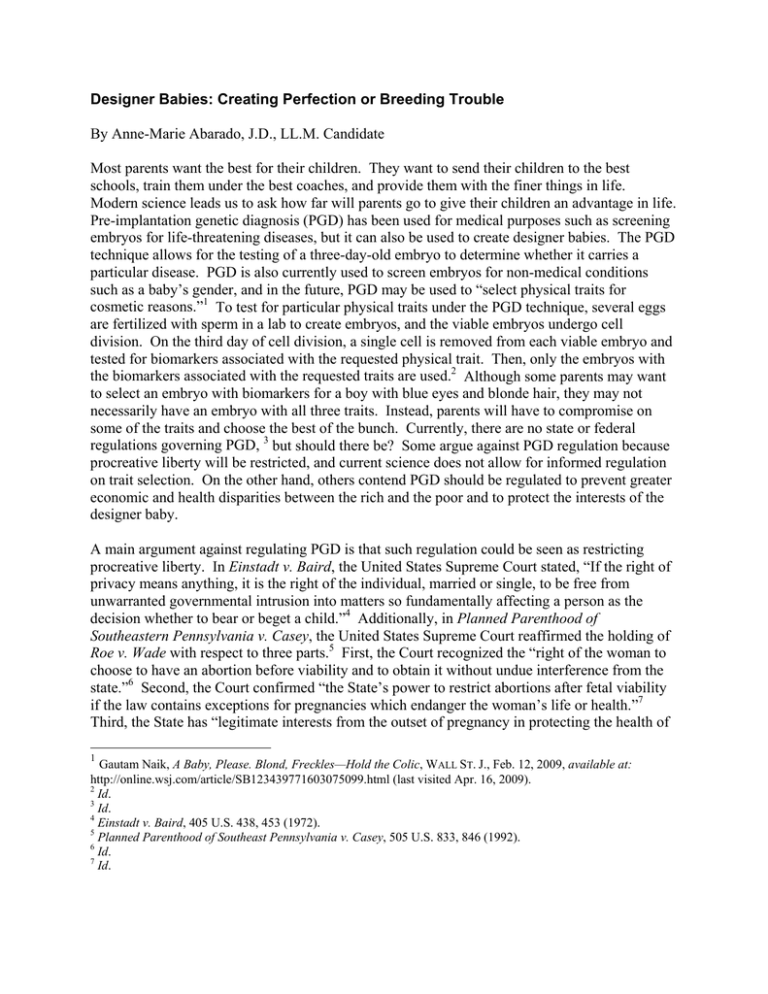
Designer Babies: Creating Perfection or Breeding Trouble By Anne-Marie Abarado, J.D., LL.M. Candidate Most parents want the best for their children. They want to send their children to the best schools, train them under the best coaches, and provide them with the finer things in life. Modern science leads us to ask how far will parents go to give their children an advantage in life. Pre-implantation genetic diagnosis (PGD) has been used for medical purposes such as screening embryos for life-threatening diseases, but it can also be used to create designer babies. The PGD technique allows for the testing of a three-day-old embryo to determine whether it carries a particular disease. PGD is also currently used to screen embryos for non-medical conditions such as a baby’s gender, and in the future, PGD may be used to “select physical traits for cosmetic reasons.”1 To test for particular physical traits under the PGD technique, several eggs are fertilized with sperm in a lab to create embryos, and the viable embryos undergo cell division. On the third day of cell division, a single cell is removed from each viable embryo and tested for biomarkers associated with the requested physical trait. Then, only the embryos with the biomarkers associated with the requested traits are used.2 Although some parents may want to select an embryo with biomarkers for a boy with blue eyes and blonde hair, they may not necessarily have an embryo with all three traits. Instead, parents will have to compromise on some of the traits and choose the best of the bunch. Currently, there are no state or federal regulations governing PGD, 3 but should there be? Some argue against PGD regulation because procreative liberty will be restricted, and current science does not allow for informed regulation on trait selection. On the other hand, others contend PGD should be regulated to prevent greater economic and health disparities between the rich and the poor and to protect the interests of the designer baby. A main argument against regulating PGD is that such regulation could be seen as restricting procreative liberty. In Einstadt v. Baird, the United States Supreme Court stated, “If the right of privacy means anything, it is the right of the individual, married or single, to be free from unwarranted governmental intrusion into matters so fundamentally affecting a person as the decision whether to bear or beget a child.”4 Additionally, in Planned Parenthood of Southeastern Pennsylvania v. Casey, the United States Supreme Court reaffirmed the holding of Roe v. Wade with respect to three parts.5 First, the Court recognized the “right of the woman to choose to have an abortion before viability and to obtain it without undue interference from the state.”6 Second, the Court confirmed “the State’s power to restrict abortions after fetal viability if the law contains exceptions for pregnancies which endanger the woman’s life or health.”7 Third, the State has “legitimate interests from the outset of pregnancy in protecting the health of 1 Gautam Naik, A Baby, Please. Blond, Freckles—Hold the Colic, WALL ST. J., Feb. 12, 2009, available at: http://online.wsj.com/article/SB123439771603075099.html (last visited Apr. 16, 2009). 2 Id. 3 Id. 4 Einstadt v. Baird, 405 U.S. 438, 453 (1972). 5 Planned Parenthood of Southeast Pennsylvania v. Casey, 505 U.S. 833, 846 (1992). 6 Id. 7 Id. the woman and the life of the fetus that may become a child.”8 Additionally in Casey, the Court states that the undue burden analysis applies, and “an undue burden exists, and therefore a provision of law is invalid, if its purpose or effect is to place a substantial obstacle in the path of a woman seeking an abortion before the fetus attains viability.”9 Although Einstadt and Casey relate to contraception and abortion, respectively, the principles utilized in those cases may be applicable in the PGD context. Unlike the context of contraception and abortion where a child will not be brought into society, in the context of PGD, the embryo will ultimately become a member of society if chosen. The state would, therefore, have an interest that vests earlier than in contraception and abortion cases because the intent is to bring a new life and a new resident of the state into being. Because of the importance we as a society place on procreative liberty, however, the state must have an extremely compelling interest before it can justify regulating PGD. The argument that PGD should be regulated to ensure that parents do not select traits that may hurt society may be a strong one in the future, but current science does not allow for informed regulation on trait selection. Selecting against certain genes in a population may result in the loss of beneficial traits. For example, sickle cell anemia is a recessive genetic disease, and PGD “can screen out affected and carrier embryos.”10 Screening out all carrier embryos, however, “may result in an evolutionary disadvantage because having only one of the sickle cell alleles produces no disease, but instead provides malarial resistance.”11 In the future, if the full effect of a certain set of genes and environmental stimuli is discovered with a resulting phenotype that is harmful to society, and its removal would have no negative consequences, the state would arguably have a compelling interest to regulate parents from selecting for the harmful trait. For example, if scientists discover a set of genes that predisposes someone to criminal behavior, and there are no evolutionary disadvantages to screening out embryos for this trait, the state could have a compelling interest in regulating PGD to prevent this trait from being passed on to designer babies for the safety of its own citizens.12 While such a scenario is a possibility, it is currently science fiction and therefore does not support a strong policy argument in favor of regulation. One reason to regulate PGD now, despite how young the science is, focuses on the potential of greater economic and health disparities between the rich and the poor. The average cost of PGD, including in-vitro fertilization, is $12,500 to $16,000.13 Some insurance companies have provided coverage for PGD to screen out serious genetic disorders, but most people have to pay PGD costs out of pocket.14 A recent study at New York University suggests that most who participated in the study would not want genetic testing for enhancements such as athletic ability 8 Id. Id. 10 Jaime King, Predicting Probability: Regulating the Future of Preimplantation Genetic Screening, 8 YALE J. HEALTH POL’Y L. & ETHICS 283, 311 (2008). 11 Id. 12 Dov Fox, Silver Spoons and Golden Genes: Genetic Engineering and the Egalitarian Ethos, 33 AM. J.L. & MED. 567, 581 (2007). 13 King, supra note 10, at 313. 14 Id. 9 or superior intelligence.15 This study, however, is limited to a specific population of consumers from a single health care facility and is, therefore, not representative of all consumers of genetic services.16 Currently, parents try to send their children to preschools and elementary schools that will give their children an early educational advantage.17 PGD would be another mechanism for parents who have the financial means to give their children an advantage early in life by selecting traits such as “IQ, work ethic, and good looks that yield the highest value in a modern market economy.”18 Although one’s genetic makeup does not necessarily guarantee success, there is a greater likelihood for success given both the genetic predisposition for traits usually equated with success and environmental stimuli from the parents. Prospective parents will likely use PGD “to the fullest extent their financial means allow.” 19 Thus, children born to parents who do not have the financial means to utilize PGD will be at a disadvantage from the moment of birth unless by luck they are born with the traits for IQ, work ethic, and good looks. Furthermore, those who have the financial means currently utilize PGD as well as amniocentesis to ensure that they and their immediate descendants select against disease genes, disease susceptibility, or certain genetic conditions.20 Those who have parents with autosomal dominant disorders have a 50% chance of getting the disorder, but PGD provides parents with the opportunity to select against having a child with the disorder.21 Moreover, by selecting against the disorder for their child, parents ensure that their child’s descendants will also not be afflicted with the disorder.22 Those who do not have the financial means for PGD, however, will not be as fortunate. “Not only will the burden of disease be placed on those least able to afford care, but it will also be placed on those least able to lobby for research and treatments.”23 Furthermore, because those with the financial means to utilize PGD will not be afflicted with the diseases suffered by those who lack the financial means to utilize PGD, there is less of an incentive for the rich to assist the poor in lobbying for research and treatments. On the other hand, if parents are allowed to select embryos against disease genes, disease susceptibility, or certain genetic conditions, they are helping society by not having severely disabled children who would require expensive care throughout their lives. Additionally, allowing parents to make the decision to select against disease genes, disease susceptibility, or certain genetic conditions protects procreative liberty. Although there is the potential of greater economic and health disparities between the rich and the poor without PGD regulation, the interest in protecting procreative liberty and the significant potential benefits to society in 15 Feighanne Hathaway, et al., Consumers’ Desire Towards Current and Prospective Reproductive Genetic Testing, J. Genetic Counseling 137, 140 (2009), available at: http://www.springerlink.com/content/k418v1755m21ktn7/?p=6a035de3f3274e7fb38f605436b47f02&pi=7 (last visited Apr. 16, 2009). 16 Id. at 143-44. 17 Michael J. Malinowski, Choosing the Genetic Makeup of Children: Our Eugenics Past—Present, and Future?, 36 CONN. L. REV. 125, 206 (2003). . 18 King, supra note 10. 19 Malinowski, supra note 17. 20 King, supra note 10. 21 Id. 22 Id. 23 Id. allowing parents to select against disease genes, disease susceptibility, or certain genetic conditions do not support a strong policy argument in favor of regulation. A strong reason to protect PGD now is to protect the interests of the designer baby. PGD can be used to screen embryos for susceptibility to Down syndrome, Tay-Sachs, and cystic fibrosis.24 Down syndrome is “associated with impairment of physical growth, reduced cognitive ability, congenital heart defects and distinctive facial features.”25 “Tay-Sachs disease causes a relentless deterioration of mental and physical abilities,” and “most children die by the age of four.”26 “Cystic fibrosis is a genetic disease that affects the mucus and sweat glands.”27 “Sticky mucus caused by the disorder leads to impairment throughout the entire body, affecting the lungs, pancreas, liver, intestines, sinuses, and sex organs.”28 Is it in the best interest of the designer baby to be born with these genetic and chromosomal disorders? Moreover, some parents may choose to select an embryo with the same disease or disability that affects them.29 Some clinics currently provide the service often described as negative enhancement.30 Groups who support negative enhancement contend, “A deaf child born to a deaf couple is better suited to participating in the parents’ shared culture.”31 Allowing parents to choose embryos with negative enhancements may not necessarily be in the best interest of the designer baby, particularly in a society where the majority of other parents may be choosing characteristics often associated with success. Not only would the child be hampered by the hearing impairment, the child may be discriminated against by a population that feels his condition could have been avoided through PGD. At what point should the line be drawn regarding what traits are in the best interests of the baby and what traits are not? Regulations should be enacted to prohibit parents from selecting traits that do not allow the designer baby to have a chance at a productive, independent life at least to the age of the average life expectancy of the population. Without regulations governing PGD, the interests of the designer baby will not be protected. PGD needs to be regulated, but to what extent? Procreative liberty should not be restricted by PGD regulations unless there is a compelling state interest. The most compelling state interest would arguably be to protect the interests of the designer baby. Thus, regulations should only be enacted to prohibit parents from selecting traits that do not allow the designer baby to have a chance at a productive, independent life at least to the age of the average life expectancy of the population. Health Law Perspectives (April 2009), available at: http://www.law.uh.edu/healthlaw/perspectives/homepage.asp 24 Id. at 290. at footnote 21. 26 Id. at footnote 22. 27 Id. at footnote 23. 28 Id. 29 Naik, supra note 1. 30 Id. 31 Id. 25 Id.
